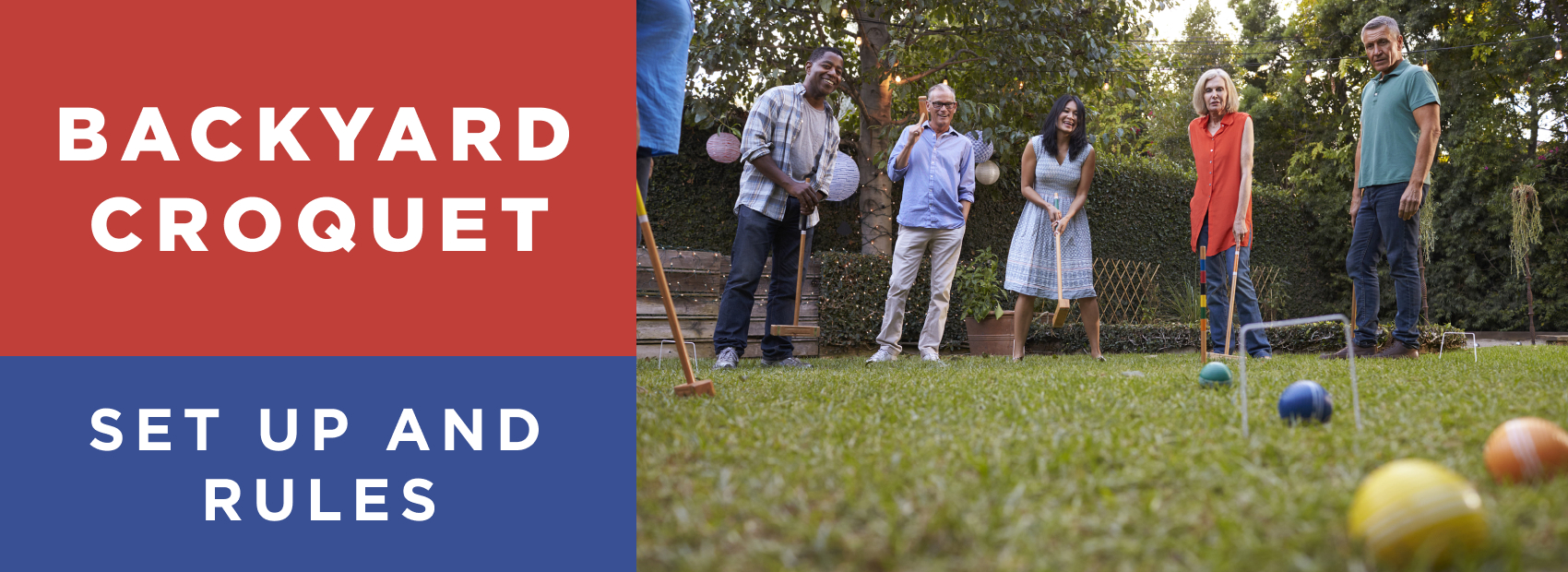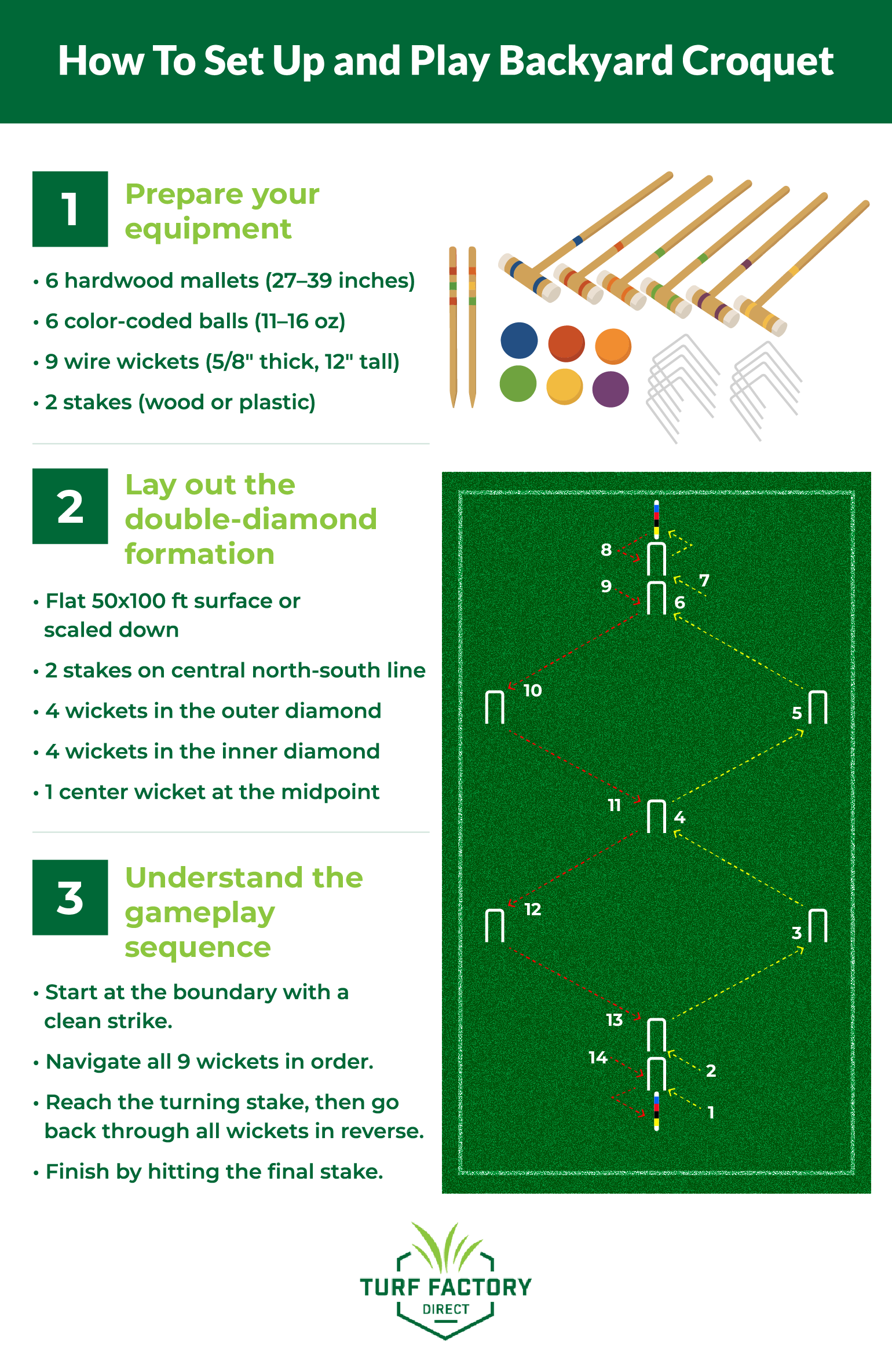
Croquet transforms your yard into a social arena: simple enough for kids to join, strategic enough to challenge adults. Picture a warm afternoon where the sun dapples through leafy branches, laughter echoing as mallets click against balls gliding across a flawless lawn. You hear the satisfying thunk of wood on wood and feel the crisp snap of freshly mown grass beneath your feet—an invitation to friendly rivalry that spans generations. Preparing this scene takes just nine wickets, two stakes, and a perfectly level turf designed for smooth play, all made better when you follow the proper backyard croquet set up and rules.
Key Takeaways
- A backyard croquet set up includes nine wickets and two stakes arranged in a double-diamond formation.
- The game centers on hitting balls through wickets in sequence using turn-based play.
- Players earn bonus shots by skillfully hitting wickets or opponents’ balls.
Typical Backyard Croquet Rules
Players take turns striking their balls, aiming to pass through a set sequence of wickets. Each player gets one stroke per turn, but skilled play can earn additional shots. The backyard croquet set up and rules focus on precision, sequence, and strategy.
Each wicket scored in the correct order adds 1 point. The game ends when a player or team hits all the wickets and then strikes the finishing stake.
Basic Playing Sequence
- Start from the lawn boundary with your ball lined up for a clean strike.
- Navigate nine wickets in order across the double-diamond course, then return along the same path.
- Strike the finishing stake to complete your game.
Each wicket you clear earns you a point; completing all courts plus the stake wins. If your ball leaves the boundary, place it one mallet-head’s length inside where it exited.
Bonus Shots
- Roquet (hit another ball): Grants two bonus strokes.
- Wicket clearance: Awards one extra shot.
- Turning stake strike: Also yields one bonus shot.
Chain these for dramatic comebacks or skillful blocks—imagine you’re one wicket away from victory, only to have an opponent’s ball stand between you and glory. Harness the tension.
Setting Up Your Backyard Croquet Court
Getting the backyard croquet court dimensions right makes all the difference between a smooth game and one full of second-guessing. A little prep ensures everyone can focus on enjoying themselves without constant rule checks or equipment problems. Following standard backyard croquet court dimensions ensures fair and enjoyable play for all.
Choosing the Right Surface and Space
Short, even grass is ideal. To set up a full double-diamond croquet court, you will need a space approximately 50 feet wide and 100 feet long. These are the standard backyard croquet court dimensions for competitive or formal backyard games but can be scaled down to accommodate the available space and shape of your yard.
Trim grass to a height of 1/4 to 3/8 inch to help balls roll cleanly. Remove anything that could obstruct play—rocks, flower pots, yard art.
Define court boundaries using rope, chalk, or string lines. Placing the court on a north-south axis can help players avoid looking straight into the sun during late-day matches. You can also consider installing backyard croquet artificial turf for consistency and reduced maintenance.
Equipment Essentials
Invest in a quality set that includes:
- Hardwood mallets (27–39 inches long) with solid handles
- Round iron wickets (5/8-inch diameter, 12 inches tall)
- Two wooden or plastic stakes
- Color-coded balls (11–16 oz, depending on turf height)
Regularly inspect for bends or warping; store in a dry shed to keep everything game-ready.
Double-Diamond Court Layout
Begin by placing the center wicket exactly halfway down the length and width of the lawn. Then measure and insert the two stakes 50 feet apart on a straight north-south line through the center.
Arrange the rest of the wickets into two diamond-shaped patterns:
- The outer diamond uses 4 wickets.
- The inner diamond also uses 4 wickets.
- One central wicket connects both layouts.
Each diamond’s wickets should sit about 6 to 8 feet apart. Take the time to align and anchor them properly—wobbly wickets make for frustrating gameplay.
Use a measuring tape or string lines to confirm spacing and symmetry across the entire setup.
Gameplay Rules and Dynamics
Croquet’s appeal lies in the decisions you make between swings. Shot selection, ball positioning, and when to go on offense or defense all come into play during each turn. Mastering backyard croquet set up and rules means making smart moves, not just accurate ones.
Basic Rules and Objective
Your goal: guide your ball through all nine wickets twice (out and back) following the double-diamond path, then strike the final stake first. Complete clearance of a wicket earns the point—“partial” doesn’t count.
Extra shots are available after a successful roquet—when your ball hits another:
- First, place your ball beside the one you struck.
- Then, take a second shot with your ball touching the opponent’s.
Turn Order and Strokes
Players rotate blue, red, black, yellow, and additional colors for more participants. Each turn starts with one stroke; bonus shots accrue through wickets, roquets, or stake strikes. Maintain proper stance: only the mallet’s head contacts the ball.
Each turn begins with a single stroke. Players may earn additional strokes by:
- Making a wicket
- Hitting another player’s ball
- Reaching the turning stake
Faults and Foul Strokes
Errors like pushing, double-striking, or moving the wrong ball end your turn immediately. Replace any errant balls to their pre-fault positions. Balls leaving the court reenter one mallet-head’s length inside at exit.
Once a player’s ball has roqueted another during a turn, it becomes “dead” on that ball and can’t earn more shots from it until the next wicket is cleared.
Team Play and Strategy
Croquet is as much about planning as it is about aim. Whether you’re on your own or playing with a teammate, smart positioning and turn anticipation shape the outcome. Knowledge of effective backyard croquet set up and rules can offer a strategic edge.
Singles vs. Doubles
- Singles: Every player runs their own course solo, perfect for two or three.
- Doubles: Partners alternate turns, using angles and blocks to support each other.
Communication elevates play: whisper plans or cheer game-changing roquets.
Strategic Tips for All Skill Levels
- Setup shots: Place your ball about six inches behind the target for power and precision.
- Court study: Visualize your path and opponents’ likely moves before swinging.
- Advanced techniques:
- Split shots to move multiple balls.
- Stop shots for perfect placement.
- Jump shots over obstructing balls.
House Rules and Variations
No two backyards are the same, and neither are the players. Tweaking backyard croquet set up and rules adds variety and can make games more welcoming for everyone.
Customizing Your Game
Adapt to your group:
- Speed scoring: Assign two points per wicket, three per stake—race to 25.
- Wicket gap adjustments: Beginners widen to 6–8 inches; pros tighten to 4 inches.
- Handicaps: Give novices extra strokes or “free taps.”
- Safe zones: Zones where balls can’t be roqueted.
Mix it up to keep every match fresh and fun. Consider how backyard croquet artificial turf allows for faster gameplay and easier maintenance with consistent ball roll.
The Joy of Backyard Croquet
Croquet invites you to slow down, laugh, and revel in both triumph and near-misses. As you place each wicket, you’re laying the groundwork for camaraderie. As you play, you’re forging new traditions—whether it’s post-dinner duels or holiday rivalries. The tactile pleasure of swinging a wooden mallet, the bright colors of balls arching across a sunlit lawn, the collective groan when someone bites the dust—these moments linger long after the game ends.
More than a sport, croquet is a moderate-intensity recreation that supports joint mobility, hand-eye coordination, and social bonds. It’s accessible, eco-friendly, and endlessly adaptable—proof that the simplest games often deliver the richest rewards. And it all begins with knowing your backyard croquet set up and rules inside and out.
Reduce Maintenance Needs with Turf Factory Direct
Elevate your croquet court from good to unforgettable with a turf solution tailored for perfect play—you’re one click away from transforming every swing into a silky glide. Explore Turf Factory Direct’s range of championship-grade surfaces and bring that dream lawn to life.








